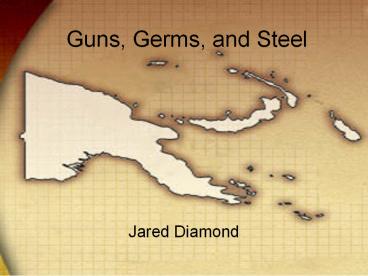Guns, Germs, and Steel - PowerPoint PPT Presentation
Title:
Guns, Germs, and Steel
Description:
Guns, Germs, and Steel Jared Diamond Jared Diamond Biologist specializing in anatomy Bird expert He believes that all humans have essentially the same potential, but ... – PowerPoint PPT presentation
Number of Views:465
Avg rating:3.0/5.0
Title: Guns, Germs, and Steel
1
Guns, Germs, and Steel
- Jared Diamond
2
Jared Diamond
- Biologist specializing in anatomy
- Bird expert
- He believes that all humans have essentially the
same potential, but that geography or the
environment has played the biggest role in
determining the haves and the have-nots.
3
Five Themes of Geography
- As you watch the film, take Cornell notes.
- Topic Hunter Gatherers to Cultivators
- Date October 9, 2007
- Answer Questions and write a short paragraph at
the end about what you found most interesting
about the film each day.
4
Questions (left column)
- Name and describe the physical characteristics of
two places in and the types of foods these places
provide. - How did humans come to depend on, adapt to, and
modify their environment to have enough food? - Why did ancient hunter-gatherers move and what
ideas moved with them?
5
Food Collection
- Hunter Gatherers are dependent on naturally
occurring sources of food such as plants and
animals. - Subsistence living having enough to survive
6
H-Gs
- Anthropologists study modern HG societies to
understand those 15,000 years old. - Be careful
- 1. HGs have lived in numerous environments.
- 2. HGs have evolved and changed over time.
7
Australian Aborigines
- Gibson Desert, Western Australia
- Low rainfall, high temperatures
- Sparsely populated.
- Bark, plants, fruit, emus, kangaroo,
- Women gather food with children along.
- Children get water
- Men Hunt from brush with spears along river.
- Small groups of nomadic people.
8
(No Transcript)
9
(No Transcript)
10
Copper Eskimos
- Canadian Arctic
- 9 month winter mostly below freezing
- Ice and snow in winter, boggy in summer.
- Winter Seal, polar bear, Spring fish, caribou,
dried fish. - Men hunt with harpoons. Women and children prep
food. (copper and bone knives) - Move to pack ice in winter, to shore for fishing
in spring, to snow drifts in fall to build
igloos.
11
(No Transcript)
12
(No Transcript)
13
(No Transcript)
14
Depend, Adapt, Modify
- What do they need? Why?
- How do they change because of the environment?
- What do they do to the environment to get what
they need?
15
Food Production
- Cultivating and domesticating plants and animals
to control natural processes of growth. - Three types of food production
- Horticulture
- Intensive Agriculture
- Pastoralism
16
Horticulture
- Growing of all types of crops with simple tools
and methods - Hand tools, sticks, no beasts of burden, no
fertilizers, no irrigation - Shifting cultivation grow crops for a few
years, grow nothing for a few years, then use
slash and burn. - Long Growth Tree Cultivation dependence on tree
crops
17
Horticulture Society
- Do not rely on plants alone.
- Raise small animals
- Nomadic but somewhat sedentary
- Able to support larger populations
- Show evidence of specialized workers
18
Intensive Agriculture
- Cultivate permanently
- Fertilizers (dung)
- Crop rotation
- Paired crops (corn/beans)
- Irrigation
- Plows and animal labor
19
Intensive Agriculture
- Towns and cities
- Specialized workers
- Complex political institutions
- Differences in wealth
- Long work days (9 hrs. day 7 days a week.)
- Reliance on single crops
- Commercialization Surplus food for sale
- More machines, corporate farms, fewer farmers
20
Pastoralism
- Primary dependence on domesticated animals
- Milk, blood, protein, wool, meat, trade?
- Nomadic move with the herds
- Small communities
- Sense of ownership
- Community decision making
21
Causes of Diversity in Food-Getting























![READ [PDF] The Rational Optimist: How Prosperity Evolves (P.S.) PowerPoint PPT Presentation](https://s3.amazonaws.com/images.powershow.com/10093138.th0.jpg?_=202408070111)







